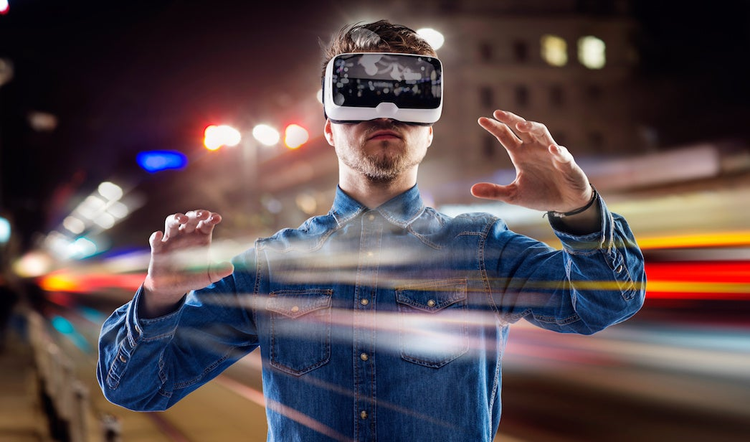Next-Generation CX Will Count On These Technologies
5G, spatial computing, visual search, and virtual humans are among the technologies that futurist Cathy Hackl is keeping a close watch on.

Cathy Hackl, lead Futurist at You Are Here Labs, has a theory about the future of marketing—one that involves the integration of immersive technologies at the strategic level.
By the way, that future starts now.

CMO.com: If you had to pick the one emerging technology you think is going to have the most immediate impact on business in 2019, which would it be?
Hackl:5G connectivity, because 5G is going to be powering a lot of next-generation experiences. 5G, and its associated low latency, is going to be critical for augmented reality, artificial intelligence, and machine learning. It’s going to have a massive impact. And it was a big point of conversation at CES 2019.
CMO.com: What about augmented reality in and of itself?
Hackl: Augmented reality is a very big part of the future of marketing and communications. AR will add utility and further context to our lives and this will change the way we go about our daily lives from anything to choosing what outfit to wear to how we get to a location or how we train for a job. It’s not a coincidence that every tech and mobile company has AR as part of the future roadmap. But I don’t see it as just one emerging technology that’s going to make the most impact. I think we should frame the conversation around the concept of emerging technologies all coming together that is going to have a real impact.
CMO.com: That’s interesting. Can you give me an example?
Hackl: Think about augmented reality and visual search. So things like Pinterest Lens and Google Lens, for example, are a combination of augmented reality and image recognition, which requires AI.
Again, I don’t think it’s about one specific technology. It’s about the sum of these emerging technologies coming together and moving forward.
CMO.com: What about some less-known or less-buzzed-about technologies you are keeping an eye on?
Hackl: I think spatial computing is going to be incredibly important as we move forward in 2019. It is really the next computing platform. The term spatial computing, which seamlessly blends digital and physical worlds, combines computer vision and artificial intelligence to seamlessly integrate virtual/digital content into the world around us. It’s how we will engage with content in the future … it’s how we will engage with technology, the next computing platform.
Right now carmakers are working on spatial awareness the most for autonomous vehicles. But add to that all these smart, interconnected appliances that work together, and you can see how spacial awareness will be important. Just imagine if the content you are engaging with and are seeing is spatially aware. The opportunities are really big here.
Spatial computing is going to change how people view and engage with the content in their space. It’s the blending, in some ways, of the digital and the physical. And 5G and computer vision play incredibly important role there, too.
CMO.com: Are we still in the early days with artificial intelligence and machine learning? Where are we headed? What are you most excited about?
Hackl: I think from a marketing perspective, in the next few months we will see more mature uses of chatbots and virtual concierges that serve a purpose. This could mean a concierge at a hotel or a hologram answering questions, but I think you’re going to start to see a lot more of these virtual humans come to the market, whether it is on social media or an actual, physical location. We already speak to Siri and Alexa; what will our voice assistants look like in the future? I see virtual or digital humans become a very big trend.
CMO.com: Is there a particular industry you think stands to benefit from that?
Hackl: We’re going to see some more of these virtual humans integrated into chatbots and being used at the prime location in hotels, definitely in retail, and even on social media.
CMO.com: Anything else marketers should keep on their radar for the next 12 to 18 months?
Hackl: Voice search and visual search. Voice search is already booming from a consumer usage standpoint, and it will become very important in marketing. But further than that, we have to also think about visual search. I heard that Instagram might be doing hashtags less and instead will dynamically tag images. This is a big indication that in the future when you’re searching for content, it’s going to be voice and visual combined.
I also think that as we move forward with autonomous vehicles being more of a reality, the driver experience is going to shift to a passenger experience. The entertainment experience is going to become critical for carmakers. Lyft and Uber are already investing in VR and AR as part of the future of the passenger experience.
I would also say to keep an eye out for location-based entertainment’s boom and facial recognition, as two other trends marketers should keep tabs on.
CMO.com: Can you provide a piece of advice for marketers in terms of which technology they should be going after for their businesses? How do they make that decision?
Hackl: I think it’s going to vary based on industry and company goals. I’ll give you an example. Build.com is online-only. They started adding augmented reality to their app, and what they saw after a few months was that products that were AR-enabled had a substantial increase in sales.
AR, for example, might not be the technology for every industry—right now. But if you sell a product and you want to find a way to personalize content to get people into the sales funnel in a very different way, augmented reality might be that technology.
From a training perspective, virtual reality and augmented reality are extremely valuable for several reasons. First of all, you have this younger generation of employees coming into the workforce. Instead of giving them a manual with 400 pages that they need to read that they are not going to read, you can put them into a headset and immerse them in this experience. It’s an attractive and engaging way to train them.
If marketers walk away with just one thing from this interview it is that content is expanding beyond 2D, to content that is 3D, 360, augmented, and sometimes holographic. Content creators, brands, and marketers need to start preparing for this shift in content.
